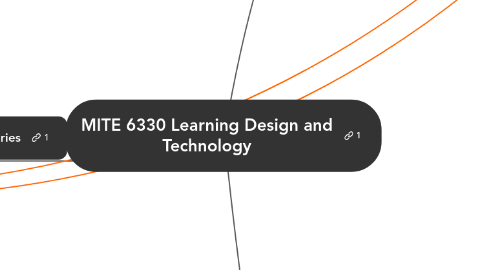
1. Learning Theories
1.1. Behaviourism (Objectivism)
1.1.1. Key Concepts
1.1.1.1. Mind as a black box and unconcerned
1.1.1.2. Focus on observable cause and effect relationship
1.1.1.2.1. Stimulus-Response
1.1.1.3. Learning occurs through interaction with environments
1.1.2. Major Theories
1.1.2.1. Connectionism (Thorndike, E., 1898)
1.1.2.2. Classical Conditioning (Pavlov, I., 1906))
1.1.2.3. Operant Conditioning (Skinner, B.F., 1938)
1.1.2.4. Social Cognitive Theory (Bandura, A., 1962)
1.1.3. Major Criticisms
1.1.3.1. Not consider other internal influences such as moods, thinking
1.1.3.2. Only consider the use of reinforcement and punishment, but not other kinds of learning
1.1.3.3. Not consider the change of behaviourial changes if new information is introduced
1.2. Cognitivism (Objectivisim)
1.2.1. Key Concepts
1.2.1.1. Open the black box
1.2.1.1.1. Mind is crucial for understanding how people learn
1.2.1.2. Mind as a information processor
1.2.1.2.1. Information Processing is governed by an internal process, not by external environment
1.2.1.3. Memory is the result of learning
1.2.1.3.1. Short-term, long-term and working memory (Atkinson-Shiffrin Model )
1.2.1.4. Knowledge is a schema or mental construct
1.2.1.5. Learning is active changes in learners' schemata
1.2.1.6. Knowledge is still viewed as given and absolute
1.2.1.6.1. Transfer of knowledge through cognitive process
1.2.1.6.2. Students remember rules, patterns and strategies
1.2.2. Major Theories
1.2.2.1. Gestalt psychology (Wertheimer, M., 1912)
1.2.2.2. Stage Theory of Cognitive Development (Piaget, J., 1920s)
1.2.2.3. Social Development Theory (Vygotsky, L., 1920s)
1.2.2.4. Cognitive Representation Theory (Bruner, J, 1960s)
1.2.2.5. Meaningful learning theory (Ausubel, D., 1960s)
1.2.2.6. Schema Theory (Anderson, R.C. , 1977 )
1.2.2.7. Attribution Theory (Weiner)
1.2.2.8. Multimedia Learning (Mayer, 1990s)
1.2.3. Major Criticisms
1.2.3.1. Knowledge is still viewed as given and absolute
1.2.3.2. Do not explain how individuals move into the next stage of cognitive or moral development
1.2.3.3. Over-simplification of treating mind as an information processor
1.3. Constructivism
1.3.1. Key Concepts
1.3.1.1. Understanding is in our own interactions with the environment (subjective mental representations)
1.3.1.2. Knowledge is constructed through assimilation and accommodation of new information (Cognitive conflicts) into the learner's previous experiences
1.3.1.3. Knowledge evolves through social negotiation and through the evaluation of the viability of individual understandings
1.3.1.4. Learning is an actively-engaged, contextual process
1.3.1.5. Learner-centered learning
1.3.2. Major Theories
1.3.2.1. Learn by Doing (Dewey, J., 1910s)
1.3.2.2. Cognitive Constructivism
1.3.2.2.1. Discovery Learning (Bruner, J., 1966)
1.3.2.3. Social Constructivism
1.3.2.3.1. Situated Learning (Lave, 1988)
1.3.2.3.2. Cognitive Apprenticeship (Collins. et al. 1990s)
1.3.2.3.3. Communities of Practice (Lave and Wenger, 1991)
1.3.3. Major Criticisms
1.3.3.1. Unpredictable outcomes
1.3.3.2. too subjective
1.3.3.3. learner must have a higher level of self-management/ maturity for success
1.3.3.4. Active learning alone is not sufficient for successful education
1.3.3.5. Learning by doing might not enhance learning for novice learners
1.4. Connectivism (Simens, G., 2004)?
1.5. Discussions
1.5.1. Evolution of Learning Theories
1.5.2. Exclusive or Complementary?
1.5.3. Key persons across different learning theories
2. Instructional Design
2.1. Key Concepts
2.1.1. Tyler (1930) Behavioural Objectives
2.1.1.1. Objectives should be stated in behavioural terms
2.1.1.2. Objectives could be served as the basis for evaluating the effectiveness of instruction
2.1.2. World War II (1940s) - Rapid Training for Military Purposes
2.1.3. Skinner, B.F. (1950s) - Programmed Instructional Material
2.1.3.1. Small, sequenced frames of instructions
2.1.3.2. Overt learner response to frequent questionings
2.1.3.3. Immediate feedback
2.1.3.4. Self-pacing
2.1.4. Miller, R.B. (1950s-60s) - Task Analysis
2.1.5. Bloom (1950s) - Learning Taxonomy
2.1.6. Gagne (1960) - Theory of Conditional Learning
2.1.6.1. Taxonomy of Learning outcomes
2.1.6.2. Hierarchy of Learning
2.1.6.3. Nine Events of Instructions
2.1.6.4. Conditions of Learning
2.1.7. Mager, R. (1970s) - Criterion Referenced Testing
2.1.8. Reigeluth, C (late 1970s) -Elaboration Theory
2.1.9. Merrill, MD. (1980s) - Component Display Theory
2.1.10. Gilbert (1980s) - Performance Management
2.1.11. Sweller, J (1990s) - Cognitive Load
2.1.12. Mayer, R.E. (2000s) - Multimedia Learning
2.1.13. Bonk, C. & Cunningham, D.(1998) - Constructivistic Teaching Practices and Principles
2.1.13.1. Cognitive Constructivism
2.1.13.2. Social Constructivism
2.2. Models
2.2.1. ADDIE
2.2.1.1. Analysis
2.2.1.2. Design
2.2.1.3. Development
2.2.1.4. Implementation
2.2.1.5. Evaluation
2.2.2. 4C/ID Model (Merrienboer, J., 1990s)
2.2.2.1. Learning Tasks
2.2.2.2. Supportive Information
2.2.2.3. JIT Information
2.2.2.4. Part-task Practice
2.2.3. Constructivist Learning Environments (Jonassen, D. 1999)
2.2.3.1. Question/Case/Problem/Project
2.2.3.2. Related Cases
2.2.3.3. Information Resources
2.2.3.4. Cognitive Tools
2.2.3.5. Conversation and Collaboration Tools
2.2.3.6. Social/Contextual Support
2.2.4. Problem-based Learning under the constructivist framework (Savery, J.R. & Duffy, T.M., 2001)
2.2.5. Online Learning Environment (Johnson, S.D. & Aragon, S.R, 2003)
2.3. Discussions
2.3.1. Learning Theories and ID
2.3.2. Cognitivism as the central role
2.3.3. Instructional sequences vs Learning Environment
2.3.4. The Best Instructional Design
2.3.5. ID as a quality assurance tool
3. Instructional Media
3.1. Timeline
3.1.1. School Muesums (1st decade of the 20th century)
3.1.2. Visual Instruction Movement (1914 - 1923)
3.1.2.1. Magic Lanterns / Steropticons (1850) - Slides in logical order for storytelling
3.1.2.2. Motion Picture Projectors (1896) - Instructional Films
3.1.3. Audiovisual Instruction Movement (1920s - 1930s)
3.1.3.1. Radio Broadcasting
3.1.3.2. Sound Recordings
3.1.3.3. Instructional Sound Motions Pictures
3.1.4. World War II Development (1930s-1940s)
3.1.4.1. Training Films
3.1.4.2. Overhead Projectors
3.1.4.3. Slide Projectors
3.1.4.4. Audio Equipment
3.1.4.5. Simulators & Training Devices
3.1.5. Instructional Television (most popular between 1950 - mid 1960s)
3.1.6. Computer ages (1950s - now)
3.1.6.1. Computer-assisted Instructions (CAI)
3.1.6.2. Micro-computers (early 1980s)
3.1.6.3. the Internet (1990s)
3.1.6.3.1. Distant Learning
3.1.6.3.2. Low cost, readily accessed learning in business, & military sector
3.1.6.4. Web 2.0 (2000s)
3.1.6.4.1. Blogs
3.1.6.4.2. wikis
3.1.6.4.3. social spaces
3.1.6.4.4. social bookmarks
3.1.6.4.5. video-sharing sites
3.1.6.4.6. podcastings
3.1.7. Teleconference (1980s)
3.1.8. Wireless Handheld Devices (Late 1990s - now)
3.1.8.1. Location aware
3.1.8.2. Immediacy
3.1.8.3. mobility
3.2. Discussions
3.2.1. Historical Impact of Instructional Media
3.2.2. Relevance of Instructional Media to educational success
3.2.3. Learning and Technology
3.2.3.1. Computer-supported collaborative learning
3.2.3.2. Learning Objects
3.2.3.2.1. Cisco Systems Reusable Information Object Strategy
3.2.3.3. Papert, S.
